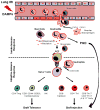Mechanisms of graft rejection after lung transplantation
- PMID: 27861263
- PMCID: PMC5443682
- DOI: 10.1097/MOT.0000000000000371
Mechanisms of graft rejection after lung transplantation
Abstract
Purpose of review: To date, outcomes after lung transplantation are far worse than after transplantation of other solid organs. New insights into mechanisms that contribute to graft rejection and tolerance after lung transplantation remain of great interest. This review examines the recent literature on the role of innate and adaptive immunity in shaping the fate of lung grafts.
Recent findings: Innate and adaptive immune cells orchestrate allograft rejection after transplantation. Innate immune cells such as neutrophils are recruited to the lung graft early after reperfusion and subsequently promote allograft rejection. Although it is widely recognized that CD4 T lymphocytes in concert with CD8 T cells promote graft rejection, regulatory Foxp3 CD4 T, central memory CD8 T cells, and natural killer cells can facilitate tolerance.
Summary: This review highlights interactions between innate and adaptive immune pathways and how they contribute to lung allograft rejection. These findings lay a foundation for the design of new therapeutic strategies that target both innate and adaptive immune responses.
Conflict of interest statement
The authors have no conflicts of interest to declare.
Figures

References
-
- Yusen RD, Edwards LB, Kucheryavaya AY, et al. The Registry of the International Society for Heart and Lung Transplantation: Thirty-second Official Adult Lung and Heart-Lung Transplantation Report--2015; Focus Theme: Early Graft Failure. The Journal of heart and lung transplantation : the official publication of the International Society for Heart Transplantation. 2015;34(10):1264–1277. - PubMed
-
- Lodhi SA, Lamb KE, Meier-Kriesche HU. Solid organ allograft survival improvement in the United States: the long-term does not mirror the dramatic short-term success. Am J Transplant. 2011;11(6):1226–1235. - PubMed
-
- Burton CM, Iversen M, Carlsen J, et al. Acute cellular rejection is a risk factor for bronchiolitis obliterans syndrome independent of post-transplant baseline FEV1. The Journal of heart and lung transplantation : the official publication of the International Society for Heart Transplantation. 2009;28(9):888–893. - PubMed
-
- Hachem RR, Khalifah AP, Chakinala MM, et al. The significance of a single episode of minimal acute rejection after lung transplantation. Transplantation. 2005;80(10):1406–1413. - PubMed
Publication types
MeSH terms
Grants and funding
LinkOut - more resources
Full Text Sources
Other Literature Sources
Medical
Research Materials

